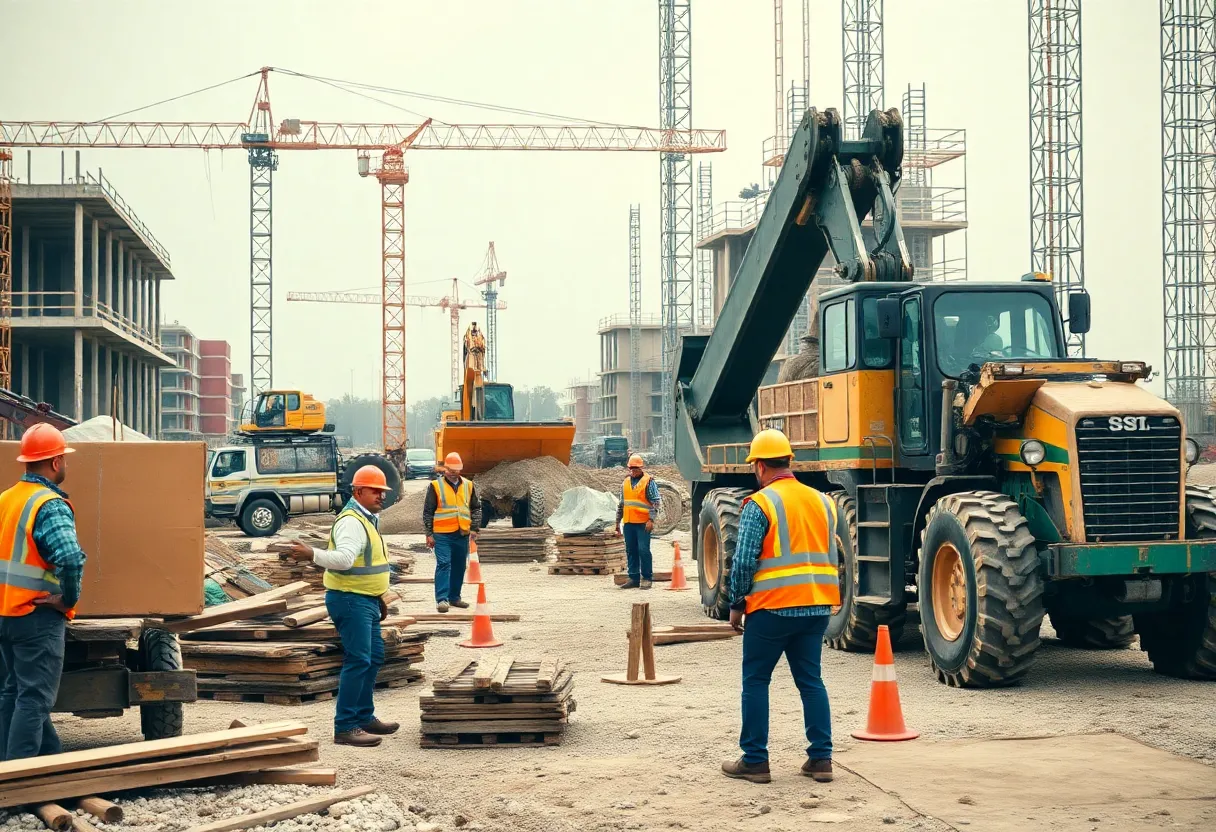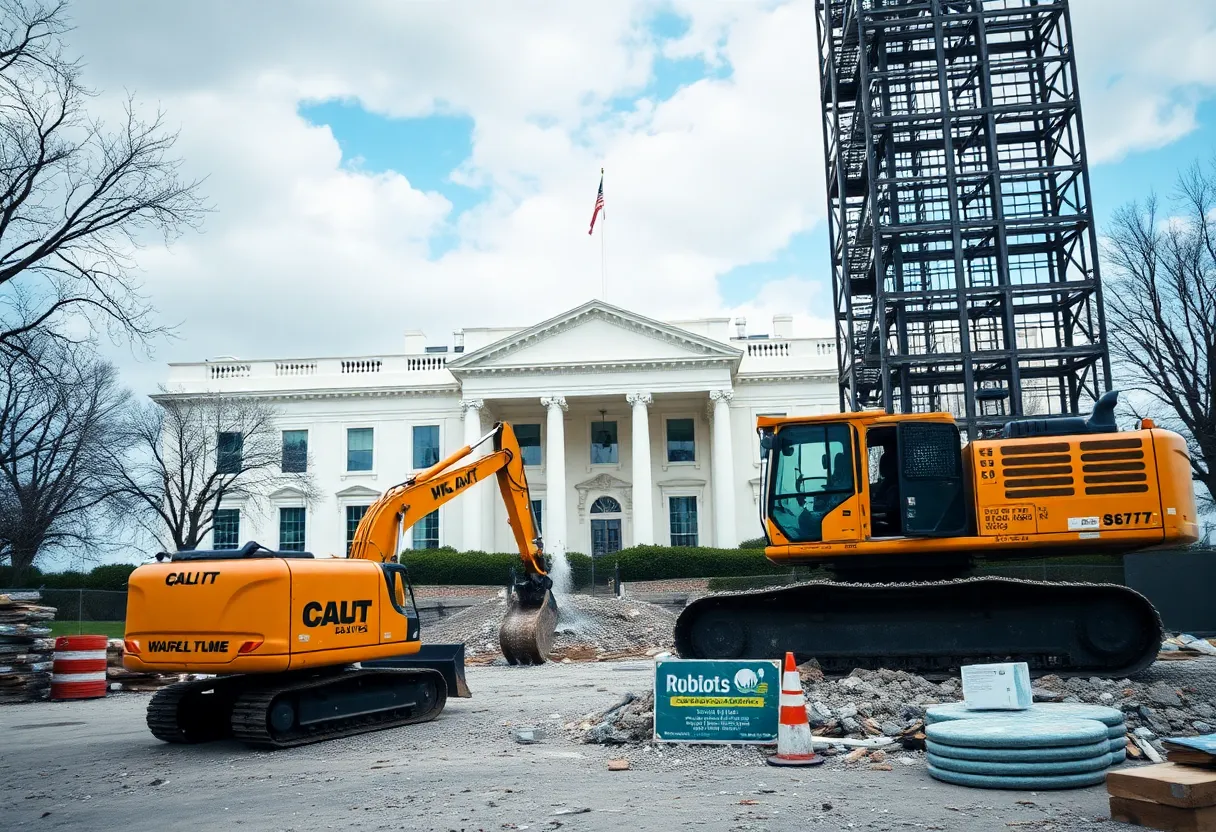News Summary
The White House East Wing is undergoing significant demolition to pave the way for a new $250 million ballroom. This modernization project incorporates cutting-edge robotics for efficient debris removal and addresses environmental concerns with recycled materials. With approvals from historic advisory boards, the construction aims to enhance functionality for presidential events while maintaining cultural sensitivity and ensuring safety during the process.
Demolition Begins at the White House in Washington, D.C.
Significant portions of the White House East Wing in Washington, D.C., are currently under demolition to make way for a new $250 million ballroom. This project aims to enhance presidential facilities with modern upgrades, marking a major development in the ongoing evolution of the historic site.
The demolition involves cutting-edge robotics for efficient debris removal, which helps minimize downtime for the building’s operations. This technology ensures that the work progresses quickly and safely, reducing disruptions. Interior designs for the new ballroom include customizable lighting and advanced audio systems, allowing for versatile use in various events. These features are intended to support a range of activities, from formal gatherings to diplomatic functions.
Historic advisory boards have given their approval for the plans, with measures in place to maintain cultural sensitivity. The project also addresses environmental concerns through the use of recycled aggregates in the foundation, a step that has drawn positive feedback from environmentalists. To manage costs, transparent audits are being conducted to monitor for any overruns, ensuring fiscal responsibility. Security remains a priority, with constant surveillance protocols implemented to prevent any intrusions during construction.
This addition to the White House is expected to redefine presidential entertaining by blending elegance with functionality, particularly for global diplomacy. The new ballroom will provide a state-of-the-art space that can adapt to different needs, enhancing the ability to host international events.
Construction details reveal that the project began recently, with the focus on careful demolition to preserve the integrity of the surrounding structures. The use of robotics not only speeds up the process but also improves safety for workers by handling hazardous tasks. The interior features, such as the customizable lighting, allow for adjustments based on event requirements, while the advanced audio systems ensure high-quality sound for presentations and performances.
Approval from historic advisory boards underscores the effort to balance modernization with respect for the site’s historical significance. The incorporation of recycled materials in the foundation demonstrates a commitment to sustainable practices, aligning with broader environmental goals. Regular audits help track expenses, providing accountability in a high-profile project like this. Enhanced security measures protect the area, given the sensitive nature of the location.
The overall impact of this project is anticipated to extend beyond the White House, potentially setting a precedent for how historic sites incorporate new technology and designs. By focusing on efficiency and adaptability, the new ballroom will support diplomatic efforts, offering a versatile venue for engagements that require both elegance and practicality.
In terms of timeline, the demolition phase is a critical first step, paving the way for construction to proceed smoothly. The project’s emphasis on minimizing downtime means that essential White House functions can continue with limited interruptions. This approach highlights the planning involved in such a large-scale endeavor.
Background on the White House East Wing dates back to its original construction, which has undergone various modifications over the years to meet changing needs. The current project represents a continuation of efforts to update the facility for modern demands, ensuring it remains a functional center for executive operations. The decision to add a ballroom stems from the need for more flexible spaces that can accommodate larger events, reflecting shifts in how presidential activities are conducted.
Historically, the White House has seen numerous renovations to adapt to new technologies and purposes, and this latest initiative follows that pattern. By employing innovative methods and materials, the project aims to maintain the building’s status as a symbol of American governance while improving its capabilities for the future.
Expanding on the environmental aspects, the use of recycled aggregates not only reduces waste but also promotes resource efficiency, which is increasingly important in construction projects. The transparent audit process ensures that the $250 million budget is managed effectively, providing a model for other government-funded initiatives. Overall, this development underscores a balance between preservation, innovation, and practicality.
The completion of the ballroom is poised to enhance the White House’s role in international affairs, offering a space that combines aesthetic appeal with cutting-edge functionality. This project exemplifies how historical sites can evolve to meet contemporary needs without compromising their core identity.
To reach the full scope, the construction team is coordinating closely with various experts to ensure all aspects are handled with precision. The integration of advanced technologies like robotics and audio systems represents a forward-thinking approach, making the White House more adaptable for future use.
In summary, this demolition and construction effort at the White House East Wing is a significant step toward modernizing a key national landmark, with careful attention to efficiency, sustainability, and security.
FAQ Section
What is the main purpose of the demolition at the White House East Wing?
Significant portions of the White House East Wing are under demolition for Trump’s $250 million ballroom.
What technologies are being used in the project?
The project employs cutting-edge robotics for efficient debris removal, minimizing downtime.
What features are included in the interior designs?
Interior designs include customizable lighting and advanced audio systems for versatile use.
Have the plans been approved?
Historic advisory boards have approved the plans, ensuring cultural sensitivity.
How are costs being managed?
Cost overruns are monitored closely, with transparent audits.
What environmental measures are in place?
Environmentalists commend the use of recycled aggregates in the foundation.
What security protocols are implemented?
Security protocols include constant surveillance to prevent intrusion.
What is the expected impact of the new ballroom?
This addition will redefine presidential entertaining, blending elegance with functionality for global diplomacy.
Key Features Chart
| Feature | Description |
|---|---|
| Demolition Technology | Cutting-edge robotics for efficient debris removal, minimizing downtime |
| Interior Designs | Customizable lighting and advanced audio systems for versatile use |
| Approval | Approved by historic advisory boards, ensuring cultural sensitivity |
| Cost Management | Monitored closely with transparent audits |
| Environmental Aspect | Use of recycled aggregates in the foundation |
| Security | Constant surveillance to prevent intrusion |
| Overall Impact | Redefines presidential entertaining with elegance and functionality for global diplomacy
Deeper Dive: News & Info About This TopicConstruction FL ResourcesDemolition of White House East Wing Starts for New Ballroom Author: Construction FL NewsThe FLORIDA STAFF WRITER represents the experienced team at constructionflnews.com, your go-to source for actionable local news and information in Florida and beyond. Specializing in "news you can use," we cover essential topics like product reviews for personal and business needs, local business directories, politics, real estate trends, neighborhood insights, and state news affecting the area—with deep expertise drawn from years of dedicated reporting and strong community input, including local press releases and business updates. We deliver top reporting on high-value events such as the Florida Build Expo, major infrastructure projects, and advancements in construction technology showcases. Our coverage extends to key organizations like the Associated Builders and Contractors of Florida and the Florida Home Builders Association, plus leading businesses in construction and legal services that power the local economy such as CMiC Global and Shutts & Bowen LLP. As part of the broader network, including constructioncanews.com, constructionnynews.com, and constructiontxnews.com, we provide comprehensive, credible insights into the dynamic construction landscape across multiple states. Construction FL News
The FLORIDA STAFF WRITER represents the experienced team at constructionflnews.com, your go-to source for actionable local news and information in Florida and beyond. Specializing in "news you can use," we cover essential topics like product reviews for personal and business needs, local business directories, politics, real estate trends, neighborhood insights, and state news affecting the area—with deep expertise drawn from years of dedicated reporting and strong community input, including local press releases and business updates.
We deliver top reporting on high-value events such as the Florida Build Expo, major infrastructure projects, and advancements in construction technology showcases.
Our coverage extends to key organizations like the Associated Builders and Contractors of Florida and the Florida Home Builders Association, plus leading businesses in construction and legal services that power the local economy such as CMiC Global and Shutts & Bowen LLP.
As part of the broader network, including constructioncanews.com, constructionnynews.com, and constructiontxnews.com, we provide comprehensive, credible insights into the dynamic construction landscape across multiple states.
Stay ConnectedMore Updates U.S. Office Construction Enters Growth Cycle Amid Declining Vacancy RatesNews Summary The U.S. office construction sector is witnessing significant growth as vacancy rates decline. This trend is driven by the return of workers and
October 22, 2025
 U.S. Department of Labor Invests $86 Million in Construction TrainingNews Summary The U.S. Department of Labor has announced an $86 million investment aimed at enhancing construction workforce training programs across 14 states. This initiative
October 22, 2025
 U.S. Construction Output Falls to 40-Quarter LowNews Summary Recent data from the Commerce Department reveals that U.S. construction output has plummeted to its lowest level in 40 quarters. This downturn spans
October 22, 2025
Would You Like To Add Your Business? |


